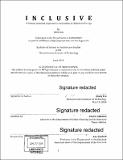Inclusive : a human centered approach to accessible architectural design
Author(s)
Liu, Jenny, S.B. Massachusetts Institute of Technology
DownloadFull printable version (11.70Mb)
Alternative title
Human centered approach to accessible architectural design
Other Contributors
Massachusetts Institute of Technology. Department of Architecture.
Advisor
Cherie Abbanat.
Terms of use
Metadata
Show full item recordAbstract
Architecture is about creating spaces for people to live their best lives, yet architecture can be disconnected from the people most directly impacted by its work. According to a survey in 2015, only 2.6% of non-architects feel that the profession does an excellent job of understanding the needs and desires of those living and working in our buildings. As such, occupants suffer spaces that are uncomfortable and sometimes unusable; in particular, people with disabilities are often restricted to certain spaces because most places are designed without any consideration of their needs.. Universal design, a new concept in architecture, asks how can we design in a way that makes life easier, healthier, and friendlier for all by putting people with disabilities on an equal playing field with other types of users. Universal design draws from accessibility standards and design principles to create environments that can be used by as many as possible without specialized design accommodations. Integrating accessibility and universal design principles in architecture could enrich our understanding of a space and add a new layer of spatial experience for everyone. The purpose of this thesis is to investigate what makes spaces inclusive and usable for those with disabilities, how we can design for a broader population, and whether we should embrace universal design ideas. This thesis will use a review of the history and current practices of universal and accessible design and precedent studies to inform a design process focused on understanding the users and their experiences in order to maximize usability. Then, this thesis will apply this knowledge by assessing the MIT Stratton Student Center and the Ray and Maria Stata Center using observations and surveys to find the gap between their designs and universal design principles. This analysis will provide findings and recommendations of how universal design can be better incorporated in public spaces on MIT's campus.
Description
Thesis: S.B., Massachusetts Institute of Technology, Department of Architecture, 2018. Cataloged from PDF version of thesis. Includes bibliographical references (pages 72-74).
Date issued
2018Department
Massachusetts Institute of Technology. Department of ArchitecturePublisher
Massachusetts Institute of Technology
Keywords
Architecture.